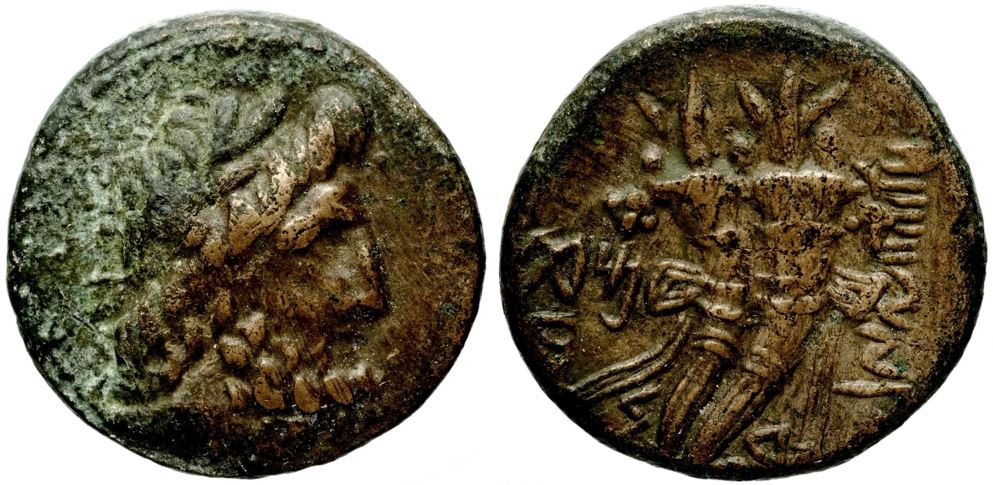3873 - Tigranocerta (AE Tigranes/Tyche) over Marathus (Zeus/cornucopiae) (Bedoukian coll. - Nercessian 1995, 48-54)
From SILVER
| Line 1: | Line 1: | ||
{{Overstrike | {{Overstrike | ||
| − | |Image overstriking coin=Tigranocerta_over_Marathus_(Maksudian_1989,_5).PNG | + | |Image overstriking coin=Tigranocerta_over_Marathus_(Maksudian_1989, _5).PNG |
| − | |Image overstruck variety visible on the overstriking coin=Tigranocerta_over_Marathus_(Maksudian_1989,_5)_-_Dessin.PNG | + | |Image overstruck variety visible on the overstriking coin=Tigranocerta_over_Marathus_(Maksudian_1989, _5)_-_Dessin.PNG |
|Image overstruck variety=Marathus Zeus Cornucopiae.JPG | |Image overstruck variety=Marathus Zeus Cornucopiae.JPG | ||
| + | |Image reference overstruck variety=https://gallica.bnf.fr/ark:/12148/btv1b8536264m | ||
|Private collection=P. Z. Bedoukian collection | |Private collection=P. Z. Bedoukian collection | ||
|Obverse description=Bust of Tigranes II to right, wearing Armenian tiara decorated with a star between two eagles and tied with a diadem, drapery on shoulders. Border of dots. | |Obverse description=Bust of Tigranes II to right, wearing Armenian tiara decorated with a star between two eagles and tied with a diadem, drapery on shoulders. Border of dots. | ||
| Line 9: | Line 10: | ||
|Mint=Tigranocerta | |Mint=Tigranocerta | ||
|Ancient region=Armenia | |Ancient region=Armenia | ||
| − | |Authority=Tigranes II of Armenia (Artaxiad king, c. 95-56 BC) | + | |Authority=Armenian kingdom; Tigranes II of Armenia (Artaxiad king, c. 95-56 BC) |
|Date from=80 BCE | |Date from=80 BCE | ||
|Date to=68 BCE | |Date to=68 BCE | ||
Revision as of 15:38, 31 May 2024
80 BCE - 68 BCE | BAΣIΛEΩΣ BAΣIΛEΩN TIΓPANOY
Images
Overstruck variety Traces of the overstruck variety
Traces of the overstruck variety
Marathus Zeus Cornucopiae.JPG [1]
Location/history
| Private collection(s)Private collection(s) ᵖ: | P. Z. Bedoukian collection |
Overstriking coin
Description
| ObverseInscription or printing placed on the obverse.: | Bust of Tigranes II to right, wearing Armenian tiara decorated with a star between two eagles and tied with a diadem, drapery on shoulders. Border of dots. | ReverseInscription or printing placed on the reverse.: | BAΣIΛEΩΣ BAΣIΛEΩN TIΓPANOY Tyche of Antioch seated on rocks right, wearing turreted crown, holding palm branch. At her feet, the upper portion of the river-god Orontes swimming right. In field, letters/monograms. Border of dots. |
Mint and issuing power
| MintIdentifies the place of manufacture or issue of a numismatic object.: | Tigranocerta | Ancient regionAncient region. | Armenia | Modern countryModern country: Turkey | AuthorityIdentifies the issuing power. The authority can be "pretended" when the name or the portrait of X is on the coin but he/she was not the issuing power. It can also be "uncertain" when there is no mention of X on the coin but he/she was the issuing power according to the historical sources: | Armenian kingdom, Tigranes II of Armenia (Artaxiad king, c. 95-56 BC) |
Chronology
| FromIdentifies the initial date in a range assigned in a numismatic context. 80 BCE toIdentifies the final date in a range assigned in a numismatic context.. 68 BCE | Hellenistic 323-30 BC |
Physical description
| MetalThe physical material (usually metal) from which an object is made.: Bronze |
WeightWeight of the numismatic object (in grams). in grams: 6.146.14 g <br />6,140 mg <br /> | DenominationTerm indicating the value of a numismatic object. Examples: tetradrachm, chalkous, denarius.: tetrachalkon |
|
| DiameterDescribes diameter of an object (in mm).: 2323 mm <br />2.3 cm <br /> | |||
References
| Coin referenceReference of the Coin: | Maksudian, 1989, p. 54, n° 5, Nercessian, 1996, p. 52, n° 73. | Coin series referenceReference to coin series study: | Bedoukian 19781Bedoukian 1978, n° 91-98 ("Antioch type", units 1, 2 and 4), Nercessian 19952Nercessian 1995, n° 48-54, Kovacs 20163Kovacs 2016, n° 124. |
| Coin series web referenceCoin series web references: | |||
Overstruck type
Description
| ObverseInscription or printing placed on the obverse.: | Head of Zeus right, wearing laurel wreath. | ReverseInscription or printing placed on the reverse.: | Double cornucopiae tied with a thin band of ribbons. |
Mint and issuing power
| MintIdentifies the place of manufacture or issue of a numismatic object. ᵖ: | Marathus | Ancient regionAncient region. ᵖ | Syria (Phoenicia) | Modern countryModern country: Syria | AuthorityIdentifies the authority in whose name (explicitly or implicitly) a numismatic object was issued. ᵖ: |
Chronology
| FromIdentifies the initial date in a range assigned in a numismatic context. 113 BCE toIdentifies the final date in a range assigned in a numismatic context.. 113 BCE | Hellenistic 323-30 BC |
Physical description
References
| Coin type referenceReference to coin series study ᵖ: | BMC Phoenicia4BMC Phoenicia, p. 125, n° 37, Duyrat 20025Duyrat 2002, serie 13 | ||
| Coin series web reference overstruckCoin series web references overstruck: | |||
Additional data
| Frequency of overstrikesFrequency of overstrikes: | Level of confidenceLevel of confidence of the identification: | ||
| RemarksRemarks: | "Obv.: above and below, letters and date (visible on reverse: In field, date and mint letters; rev.: (visible on obverse: border of dots)" | ||
References
- ^ Bedoukian, Paul Z. (1978), Coinage of the Artaxiads of Armenia, RNS Special Publication Number 10, London, 81 p.
- ^ Nercessian, Yeghia T. (1995), Armenian Coins and Their Values, Armenian Numismatic Society Special Publication 8, Los Angeles.
- ^ Kovacs, Frank (2016), Armenian coinage in the classical period, Classical Numismatic Studies 10, Lancaster, 83 p.
- ^ Hill, George Francis (1910), A Catalogue of the Greek coins in the British Museum. vol. XXIII : Phoenicia, London, The Trustees, p. 361, pl. 45.
- ^ Duyrat, Frédérique (2002), "Les ateliers monétaires de Phénicie du Nord à l'époque hellénistique", in Christian Augé, and Frédérique Duyrat (eds.), Les monnayages syriens. Quel apport pour l'histoire du Proche-Orient hellénistique et romain ?, Beirut, p. 21-70.